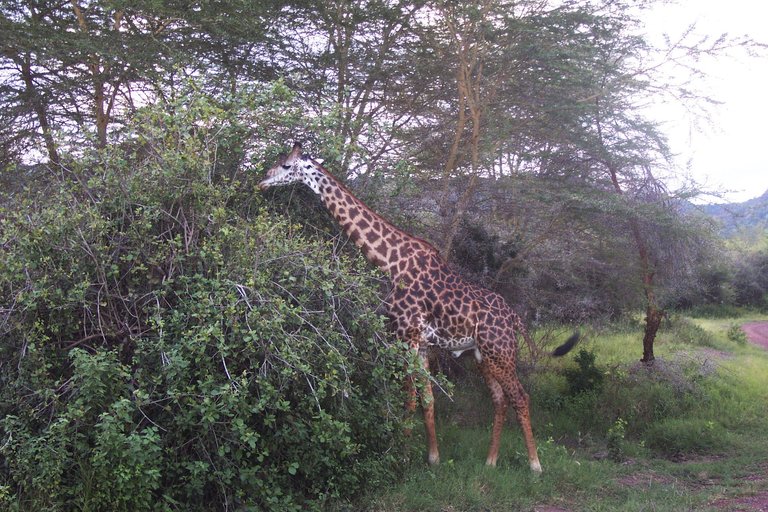Why should we care about giraffes? Yes, they are beautiful and graceful. That's reason enough for me. But is that enough for others to take an interest in this, the tallest of earth's land animals? There are more, what some might describe as practical, reasons for caring about giraffe survival.
Giraffes play a significant role in the environment. They forage at the very top of trees, where other animals cannot reach. By doing so, they act as nature's landscapers. Studies have shown that giraffes do not compete with other foragers, such as elephants and camels. As a matter of fact, it has been suggested that the giraffe's long neck is an adaptation, an instance of natural selection. Literally, no other land-based forager can reach the heights that a giraffe does when it feeds.
Giraffe in Tanzania, Foraging
Credit: Remi Jouan. Used under Creative Commons Attribuiton-share alike 3.0 unported license.
We have often heard that everything in the ecosystem is connected and that removing one element from that system has an echo effect, seemingly far removed from the affected element. That echo effect, in the case of the giraffe, has been demonstrated by a number of studies. One, for example, shows how eliminating foraging giraffes increases the presence of venomous snakes.
Snouted Cobra, Found on Kenyan Savanna

Credit: Marius Burger. Public domain.
Tracing the trail of this giraffe/snake relationship is fascinating and instructive. In a study conducted by U.S. researchers, large herbivores (i.e., elephants and giraffes) were removed from swaths of the Kenyan savanna. In their absence, the population of a particular rodent, the pouched mouse, doubled. Attracted by this increased food supply, the venomous snake population also grew. In addition to the increase of snakes and mice, the absence of the large grazing herbivores resulted in an explosion in the flea and tick population--which of course increased the likelihood of disease transmission to humans.
One specific species of tree has an established relationship with giraffes--the acacia.
Acacia Tree and Vegetation, Kenya
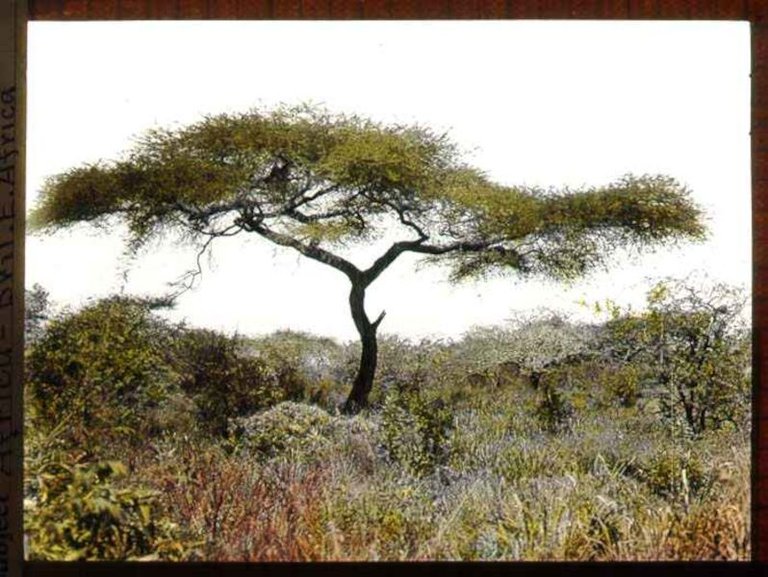
Credit:The Field Museum Library. Public domain.
In certain parts of Africa, the acacia plays a vital role in the ecosystem: in particular, the Acacia tortilis is a keystone species across arid parts of Africa. The trees have long roots that reach deep into the soil in search of water, and this renders them drought resistant. They flourish where other trees may not. As they flourish they offer shelter to many creatures, including large mammals, insects and birds. Thus the acacia helps to maintain the biodiversity of arid areas in Africa.
Pseudomyrmex-ferruginea, the Acacia Ant
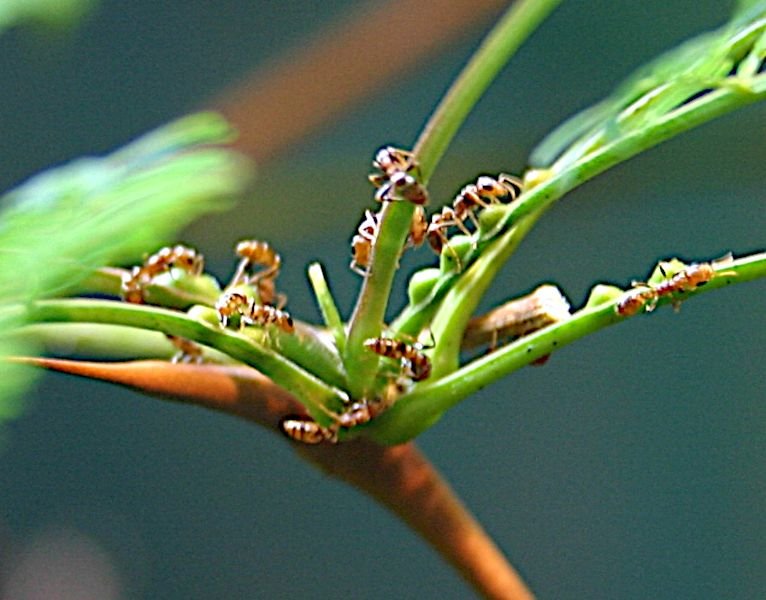
Credit: Ryan Somma. Used under Creative Commons Attribution-share alike 2.0 Generic license.
An example of the acacia offering refuge is its symbiotic relationship with the acacia ant. The tree houses the ants, by offering them specialized hollows. It also feeds the ants with nectar. In return, the ants protect the plant from herbivores. They attack the feeding animals en masse. Vibrations from the grazing herbivore alert the ants to an intruder's presence. Recent studies show that the ants also protect the acacia from pathogens that grow on its leaves.
Perhaps one of the most important functions of the acacia tree is its nitrogen-fixing properties.
Nitrogen Cycle
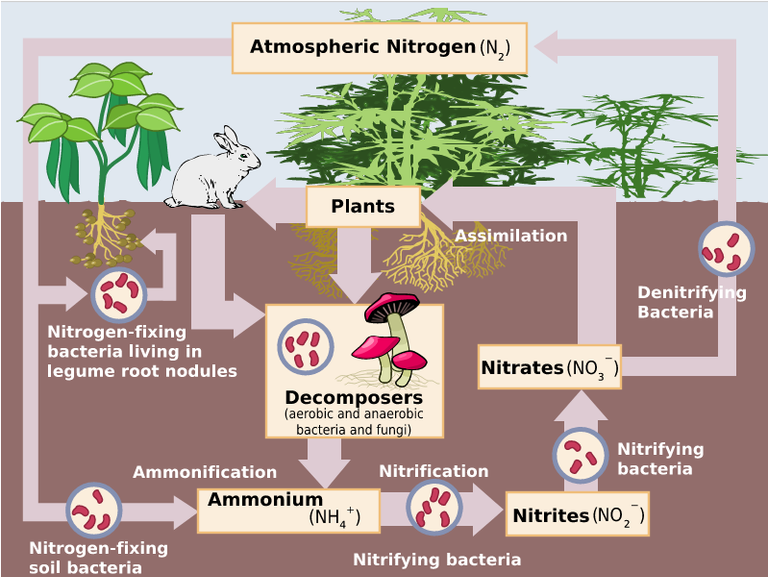
*Credit: Cicle_del_nitrogen_de.svg: Cicle_del_nitrogen_ca.svg: Johann Dréo (User:Nojhan), traduction de Joanjoc d'après Image:Cycle azote fr.svg. derivative work: Burkhard (talk)Nitrogen_Cycle.jpg: Environmental Protection Agency derivative work: Raeky (talk). Used under CC Attribution-share alike 3.0 unported license..
The diagram above shows how atmospheric nitrogen is processed and then used by plants. In the case of the acacia, its leaves are rich in nitrogen and have been credited by some with replacing artificial nitrogen sources for agriculture. When the leaves fall to the ground in the wild, they are equally effective at fixing nitrogen. Thus, the enriched soil gives rise to new plant growth.
Giraffes help to propagate foliage in several ways. They not only trim trees, but they also are important in seed dispersal. Because the giraffe travels great distances, it spreads seeds through its dung.
New tree growth is not only promoted through dung dispersal, but also through direct transportation of pollen. One plant the giraffe serves in this way is the knobthorn tree.. As the giraffe forages in the branches of this tree, pollen sticks to its long neck. The giraffe then leaves, travels a long distance, and drops pollen along the way.
Bird (White-crowned Shrike) Perching on Branches of a Knobthorn Tree
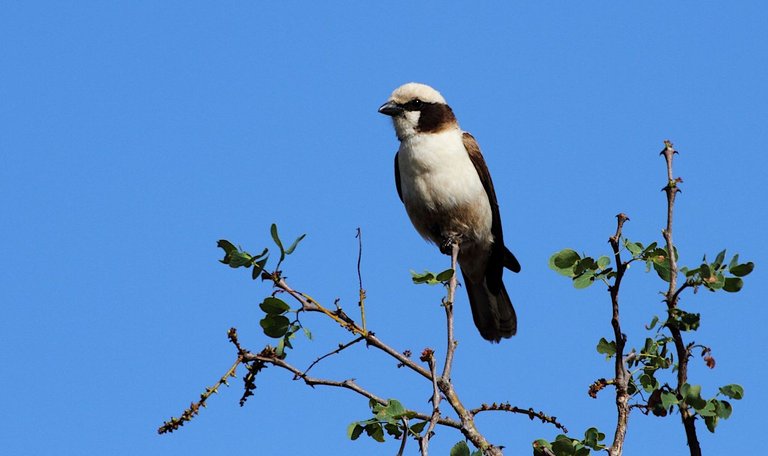
Credit: Alandmanson. Used under Creative Commons Attribution share alike 4.0 International license.
Giraffes Are a Declining Species
Giraffes in the wild exist only in certain areas of Africa. Since the 1980s, the number of giraffes has been dwindling. In that time, the global population of giraffes has dropped about 30%, and several of the twenty-one identified giraffe species have been listed by the IUCN as endangered or critically endangered.
The reasons given for the decline in giraffe population are familiar: loss of habitat (because of human incursion), poaching, and climate change (drought). Giraffes do not need much water to survive. Most of their water is consumed through the leaves they eat. Still, they do seek water every several days.
Giraffes and a Car Racing
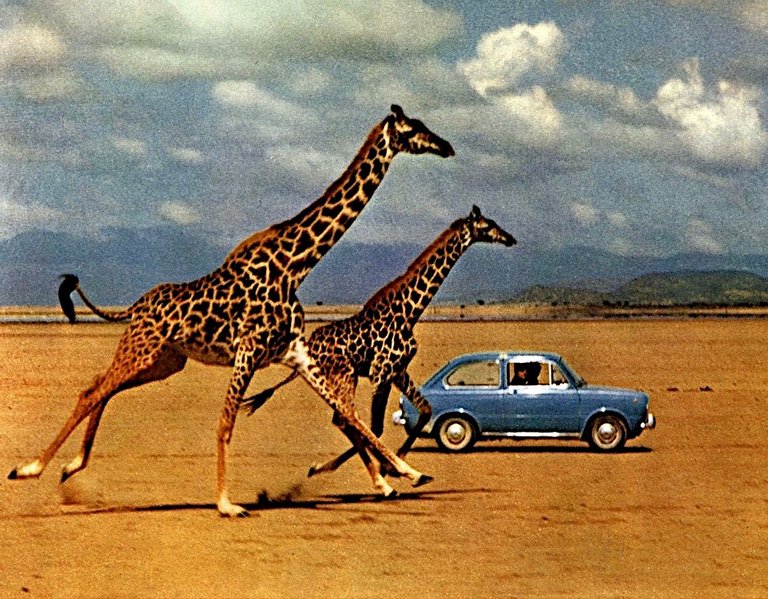
Credit: author unknown. From an advertisement for a car, 1964. Public domain in Italy, where its copyright has expired.
Although giraffes may be found only in Africa today (outside of zoos, of course), the species seems to have originated in Europe.
Ampelomeryx, Giraffe Ancestor, Spain, Some Twenty Million Years Ago
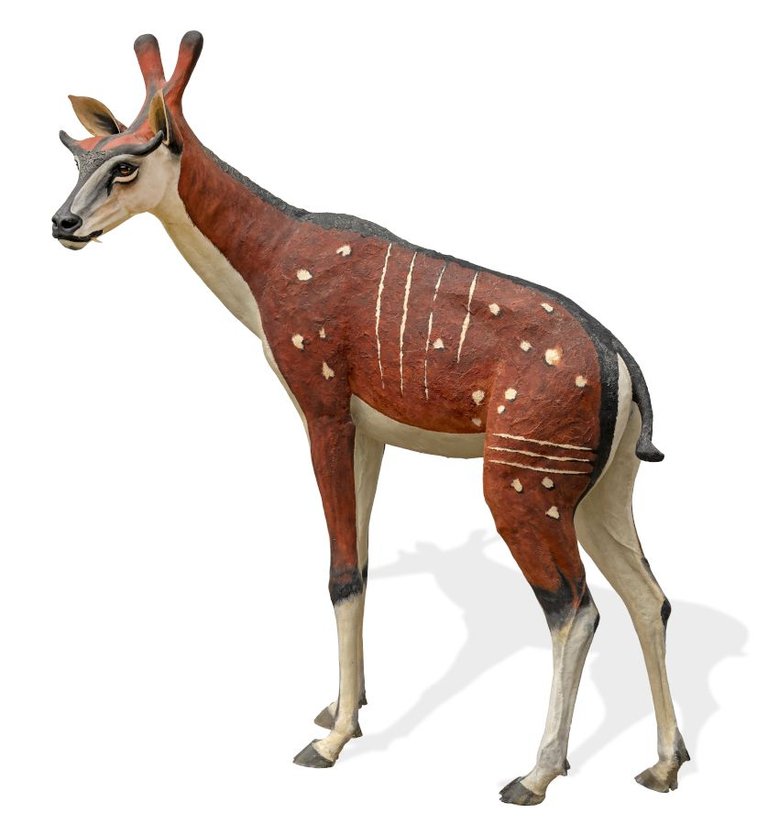
Credit: Didier Descouens. From Muséum de Toulouse. This file is licensed under the Creative Commons Attribution-Share Alike 4.0 International license.
These gentle animals have an average lifespan of about 25 years. Giraffes are social animals. They gestate their young for about 15 months. While a giraffe may leave its mother's side after two years, it is known that the offspring can maintain a relationship with the parent and may return from time to time to visit.
Newly born giraffe are cared for in a community nursery. Several females watch the young as their mothers go off to forage.
Giraffes With Baby
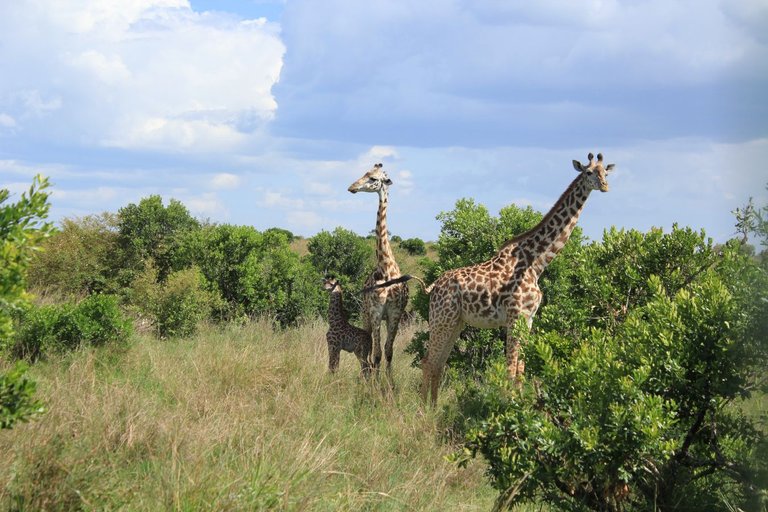
Credit: Bjarki781. Used under CC Attribution-Share alike 4.0 International license.
Giraffes are polygamous. A dominant male will mate with all the females in a herd. Because of the competition for partners, male giraffes may not mate until they are six or seven years old. Females breed at an earlier age, usually three or four years of age.
Giraffes mate throughout the year, but with a fifteen month gestation period, there is generally a gap of two years between births. Usually it is a solitary calf, but sometimes there are twins.
Efforts to Save the Giraffes and Rebuild the Population
The efforts to save the giraffe are focused mostly on habitat rehabilitation. Planting acacia trees is one way to do this. Also, there are vigorous anti poaching mechanisms.
One approach to rebuilding the giraffe population is to breed them in zoos. This does not work out too well for the animal.
Giraffes in Perth (Australia) Zoo

Credit: Calistemon. Used under Creative Commons Attribution-share Alike 4.0 International license.
Zoos and Giraffes
Zoos confine and display giraffes. The animals in captivity are usually shadows of their wild brethren. For an animal with such a wide foraging range, the zoo enclosure is cruel. The average range for a male giraffe (females have smaller ranges) in the wild is 97.87 square miles. In a zoo, the average enclosure size is 0.001875 square miles. Additionally, giraffes. highly social animals, are often kept in situations where they have minimal social bonds.
A Youtube video of two giraffes showing affection (possibly a courting ritual):
It is often the case that a giraffe suffers reduced longevity when it is in captivity.
Conclusion:
I hope you enjoyed this little essay on giraffes. I have recently become very interested in these lovely, graceful creatures and thought I'd share what I learned with the Hive community.
Thank you for reading my blog. Hive on!
Selected Sources Used in Writing This Blog
plus one origins
https://www.ncbi.nlm.nih.gov/pmc/articles/PMC4668073/
https://www.toppr.com/ask/question/which-is-the-tallest-animal-on-the-earth/
https://championsforwildlife.org/giraffe-facts/
https://www.eurekalert.org/news-releases/720472
https://www.nathab.com/blog/the-giraffe-african-savanna-relationship-its-complicated/
https://www.rentokil.co.ke/snakes/species/
https://bmcecol.biomedcentral.com/articles/10.1186/1472-6785-7-4
https://www.safariventures.com/discovering-the-wonders-of-africas-iconic-acacia-tree/
https://www.sciencedirect.com/science/article/pii/S0960982219300090
https://www.mpg.de/7747062/ants-acacia-plants-pathogens
https://erudef.org/acacia-plant-secret-to-improved-soil-fertility-and-optimum-production/
https://www.centralfloridazoo.org/animals/giraffe-2/
https://www.naturalhistorymag.com/htmlsite/master.html?https://www.naturalhistorymag.com/htmlsite/editors_pick/1992_08_pick.html
https://giraffeconservation.org/facts/how-many-giraffe-are-there-and-are-they-endangered/
https://iucn.org/
https://www.pbs.org/wnet/nature/blog/giraffe-fact-sheet/
https://www.deviantart.com/willemsvdmerwe/art/Ampelomeryx-ginsburgi-595242836
https://denverzoo.org/wp-content/uploads/2018/09/Reticulated-giraffe.pdf
https://a-z-animals.com/blog/giraffe-gestation-period-how-long-are-giraffes-pregnant/
https://www.giraffa.co/giraffe/
https://friendoftheearth.org/conservation-project/save-the-giraffes/
https://www.bornfreeusa.org/campaigns/animals-in-captivity/confined-giants/
https://www.sciencedirect.com/science/article/abs/pii/S0003347219300260
https://www.bornfreeusa.org/2022/06/16/zoo-captivity-a-welfare-disaster-for-giraffe/
https://www.bornfreeusa.org/2022/06/15/new-report-reveals-the-suffering-of-giraffes-in-zoos-and-calls-for-a-phase-out-of-keeping-these-complex-animals-in-zoo-captivity
